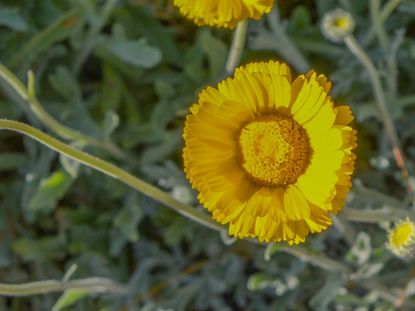Desert Marigold Information - Learn How To Grow Desert Marigolds


It's often difficult to choose the right plant for a dry, hot and windy landscape. Even extra effort from the gardener sometimes can't make plants grow in this situation. If your landscape has such conditions, try growing tough and pretty desert marigold plants. Desert marigold information says these showy, solitary flowers thrive in these difficult conditions.
Desert Marigold Information
Botanically called Baileya multiradiata, desert marigold flower is also called paper daisy, as mature blooms have a papery texture. They are also sometimes known as desert Baileya. Desert marigold plants may reach a foot in height with big, yellow flowers that produce lots of seeds. Some of the clumping, daisy-like mounds of flowers are shorter. The plant is an herbaceous, short-lived perennial, returning again next year. Blooms begin in spring and may continue through summer. Caring for desert marigold is simple as this specimen is basically carefree.
How to Grow Desert Marigolds
Get started growing the desert marigold flower by planting seeds in a sunny area. Desert marigold plants are not picky about soil types, but they do need good drainage. Furry, silvery foliage will soon appear, followed by blooms of the desert marigold flower. While it's not necessary to water regularly, an occasional drink makes flowers grow quickly and results in a bigger bloom. Caring for desert marigold is this easy. Use desert marigold plants as part of a wildflower garden in hot, dry areas. Once planted, the desert marigold flower drops seeds for multiple plants to grow from later on. If reseeding is not desirable for your landscape, remove spent blooms before the seeds drop. This deadheading also encourages more flowers to bloom. Now that you've learned how to grow desert marigolds, get some planted in the desert landscape where other plants are hard to grow. Information about desert marigolds say they're native to Mexico and grow well in most western areas of the United States. Plants may be damaged when temperatures reach below freezing, so protection in these situations may be necessary.
Gardening tips, videos, info and more delivered right to your inbox!
Sign up for the Gardening Know How newsletter today and receive a free download of our most popular eBook "How to Grow Delicious Tomatoes."

Becca Badgett was a regular contributor to Gardening Know How for ten years. Co-author of the book How to Grow an EMERGENCY Garden, Becca specializes in succulent and cactus gardening.
-
 10 Best Apartment Plants To Turn Your Small Space Into An Oasis
10 Best Apartment Plants To Turn Your Small Space Into An OasisThe best apartment plants can lend an ambience of the tropics, brighten up a space, or add a touch of drama, and turn an apartment into a relaxing oasis.
By Amy Grant
-
 Grow a Bathroom Oasis: 8 Best Bathroom Plants With No Light or Low Light
Grow a Bathroom Oasis: 8 Best Bathroom Plants With No Light or Low LightSome apartment dwellers grow the best bathroom plants with no light or low light. Read how one of our favorite plant lovers does it in the big city.
By Teo Spengler